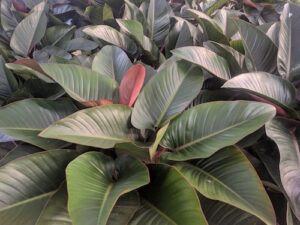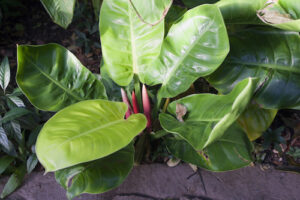Philodendrons –- Your Ideal Office Companions
by Elaine Homstad, Fairfax Master Gardener
Some of the most popular indoor plants around the world are philodendrons. This extremely large group of foliage plants has over 400 varieties and is incredibly varied in size, growth habit and color. Philodendrons are permanent inhabitants in many homes and offices because of their low maintenance and unfussy light and watering needs.
They often thrive under office ceiling lights and can easily go 7 to 10 days without watering, which makes them well suited to an office environment.

Birkin’ and ‘Congo Green’ Philodendrons
When my daughter got her first office job many years ago, I gifted her a ‘Moonlight’ philodendron in a 5-inch pot. It lived happily on a file cabinet, then on her desk, and as it grew taller, eventually on the floor. Although this variety is supposed to be a “clumper” rather than a “climber,” it decided not to conform to its plant label and kept growing taller and taller. By the time she left that office several years later, it had almost reached the ceiling. We had to cut off the top when it was moved to her condo, where it survived for several more years but never achieved the height it had in the office.
Philodendrons, like many houseplants, have origins in tropical forests. In their native environments of Central and South America, they are an understory plant, and therefore prefer indirect light. Their lush foliage makes them stunning specimen plants, such as the popular so-called split-leaf philodendron Monstera deliciosa. Although it is not technically a philodendron, it is in the same family of plants, Araceae. Other beautiful ‘floor’ philodendrons include ‘Xanadu,’ ‘Congo,’ ‘Birkin’ and Selloum.

‘Congo’ philodendron
Philodendrons fall into two growth habit categories — vining and upright. The vining type have aerial roots and can be grown in a hanging basket or alternately twining up a trellis. The heartleaf philodendron (Philodendron hederaceum) with its shiny, waxy, dark green heart-shaped leaves is often confused with Pothos, another vining houseplant that is also in the family Araceae. This philodendron is an awesome plant for a bathroom, as it loves high humidity. It is also available in a variety called ‘Brasil’ whose leaves are a variegated green and gold.
The upright varieties have many unique characteristics, although their growth habit is similar. They range in size, leaf shape, color and variegation. The smaller ‘tabletop’ varieties offer such beauty that it is hard to choose just one type, but you really don’t have to. You can fill your home or office with many of these lovelies. Two particularly striking ones are ‘Moonlight’ (whose new growth emerges a bright chartreuse color) and ‘Prince of Orange’ (new growth appearing as a coppery reddish-orange) before both change to a darker green.

‘Moonlight’ philodendron
One caution about philodendrons around cats, dogs and young children. Plants in the Araceae family contain insoluble calcium oxalate crystals that can cause irritation in the mouth and esophagus if ingested. As noted earlier, most “phillys” are relatively low maintenance and do well by following a few simple rules:
Water regularly but not too frequently. Allow the top inch of soil to dry out before watering. A seven to ten-day schedule is usually ideal.
Fertilize every other watering with a 1/2 dose of water-soluble fertilizer.
Do not place in direct sunlight. Artificial or office lighting works well, or indirect light through a window. They like to summer outdoors or on a screened porch, but only in a shaded area.
Remove yellowed or dried leaves if they appear.
Prune to keep it an appropriate size. Repot if it becomes rootbound.
Inspect for aphids and mites. Treat with an insecticidal soap if present.
Propagate through cuttings. Vining types will root in water. Use a soilless mix and a rooting hormone powder for uprights.
Keep away from children and pets.
Resources
Philodendron, Karen Russ, Al Pertuit and Barbara Smith, Clemson Cooperative Extension, Home and Garden Information Center
Philodendron Varieties: How To Grow Indoors, Jon Vanzile, The Spruce